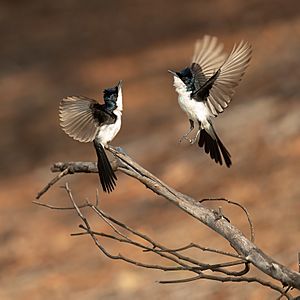Paperbark flycatcher facts for kids
Quick facts for kids Paperbark flycatcher |
|
|---|---|
 |
|
| Conservation status | |
| Scientific classification | |
| Genus: |
Myiagra
|
| Species: |
nana
|
| Synonyms | |
|
|
The paperbark flycatcher (Myiagra nana), also called the little restless flycatcher, is a small passerine bird. This means it's a perching bird, like many songbirds. It belongs to the Monarchidae family. You can find it in the warm, tropical woodlands and along rivers in northern Australia and southern New Guinea.
For a long time, some scientists thought the paperbark flycatcher was just a special type of the restless flycatcher. The restless flycatcher lives in southern and eastern Australia. However, scientists now know they are two different species.
Contents
About the Paperbark Flycatcher
How Scientists Study Birds
The paperbark flycatcher was first described by a scientist named John Gould in 1870. He called it Seisura nana. For many years, people thought it was a subspecies (a distinct group within a species) of the restless flycatcher.
But in 1999, two scientists, Schodde and Mason, looked closely at these birds. They found that the paperbark flycatcher was very different. It didn't mix with the restless flycatcher, even where their living areas were close. This showed it was its own unique species.
What Does It Look Like?
The paperbark flycatcher looks a lot like the restless flycatcher. It has completely black feathers on its head and upper body. Its throat and belly are entirely white.
However, the paperbark flycatcher is much smaller. It weighs only about two-thirds as much as its southern relative. It also has a shorter, wider beak. The bristles around its beak, called rictal bristles, are longer and stronger. There is no size overlap between the two species.
The back and head of the paperbark flycatcher are both shiny black. The restless flycatcher, though, has a slightly lighter, slate-grey back. They also make different sounds. The paperbark flycatcher almost never makes the "scissors-grinding" call that the restless flycatcher is known for.
Where It Lives
Distribution and Habitat
You can find the paperbark flycatcher in northern Australia. Its range stretches from the Kimberley region in Western Australia. It goes across the Top End of the Northern Territory. Then it reaches the Gulf Country and south-western Cape York Peninsula in north-west Queensland. There is also a group of these birds on Saibai Island in the Torres Strait.
The bird also lives in southern New Guinea. You can find it from Merauke eastwards to the Bensbach River. This river is in the Middle Fly District.
The paperbark flycatcher and the restless flycatcher do not live in the exact same places. Their areas meet in northern Queensland. But there are no signs that the two species mix there. Most restless flycatchers in that area are just visiting and not breeding.
In Australia, the paperbark flycatcher likes tropical eucalypt woodlands. It also lives in paperbark woodlands and dry riverine woodlands. In New Guinea, it is common along the lower parts of the Bensbach River. Here, it prefers scrub, partly underwater trees, and sedgeland next to rivers. These areas are often on floodplains and savannas.
Behavior
The paperbark flycatcher is a bird that is easy to spot. You will usually see it alone or in pairs. It often moves its tail from side to side. This is why it's sometimes called "restless."
When it's looking for food, it often hovers close to the ground. It uses this hovering to find insects and other small creatures to eat.
Reproduction
Scientists don't know much about the nesting habits of these birds in New Guinea. But in northern Australia, they breed from November to January.
Their nest is a neat cup shape. They build it from pieces of bark and grass stems. They usually place the nest in the fork of a dead bush or tree that is near water. The female bird lays one whitish egg. This egg has reddish-brown and grey spots.
See also
 In Spanish: Monarca chico para niños
In Spanish: Monarca chico para niños


